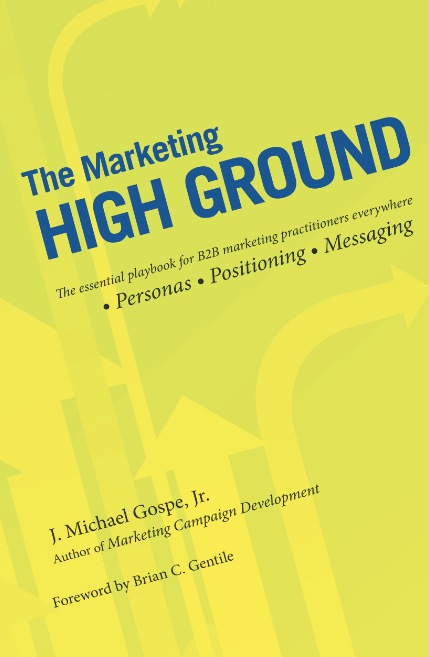An excerpt from The Marketing High Ground, available Spring 2011
When I ask marketers to show me the “positioning statement” they’ve crafted, I get a wide variety of illustrations. It’s not uncommon for a marketing communications manager to boldly recite their slogan—five or ten words spoken with conviction and energy. On occasion, I’ve had product-marketing managers and sales reps hand me a multi-page document that recites their company’s history. “Read this!” they say with annoyance, as if the positioning should be obvious to me. In other cases, I’ve been lectured by product managers about their technology or handed a twenty-page document with many tables, graphics, and notes scribbled in the margin. Sometimes marketers believe their data sheet is the positioning statement; in other cases, it’s a (very long) Microsoft PowerPoint™ presentation used by sales. And most often, it’s not a statement at all. Instead, the positioning thought is buried deep within a lengthy marketing plan, with positioning statement elements scattered across the pages, putting the burden on the reader to make sense of it all.
While each of these examples (tagline, company history, technical whitepaper, presentations) is an important deliverable along the continuum of a product’s lifecycle, none of them is a true statement of the product’s position in the marketplace. The tagline is a string of words designed to be memorable, while conveying a brand promise with emotion. It is an output or a result of having a good positioning statement. The same goes for customer-viewable presentations and whitepapers. The numerous tables, charts, scribbles-in-the-margin documents are best thought of as inputs that will guide the development of a positioning statement. Crafting a well-thought-out positioning statement takes time; it’s a process of discovery. It’s easy to capture notes, opinions, facts, and figures. Instead of prioritizing and making hard choices to hone the product’s go-to-market strategy, we jam-pack every bit of detail into a corporate presentation and expect the prospective customer to sort out what is really important. This only confuses customers and unnecessarily lengthens the sales cycle.
Instead, marketers need a template to help them distill all this important information down into a crisp, tightly focused positioning statement that everyone in the organization can understand with clarity and conviction.
So, by definition . . .
The positioning statement is a subset of a value proposition that optimizes it for marketing communications purposes. It identifies the target audience, the product and its category, a specific benefit, and is differentiable from the nearest competitive alternative. It is an internal, non-emotional statement that becomes the messaging cornerstone of an integrated marketing campaign.
There is often confusion between value propositions and positioning statements. While they are often used interchangeably, it is important to understand the differences. Value propositions encapsulate a summation of benefits offered to multiple market segments and the price for those benefits. Positioning statements, in turn, represent a plea for single-mindedness and an opportunity to be focused on one audience at a time while exercising only a relevant differentiable benefit. Multiple positioning statements may be encompassed by a broader value proposition. The Marketing High Ground (available this Spring on Amazon.com) explores the elements of crafting and communicating an effective positioning statement and how and why this is crucial to a marketer’s success.






good read, might want to visit this site more than once.
Trusted resource! Thank you for cutting through the clutter.
Thanks for your insight on this intriguing topic.
I’m so delighted that I located your blog because it will definitely assist in my future investing decisions. I will surely visit again. Also, do you have a newsletter for your blog? I didn’t
notice where to sign up on the site.
“What is a “positioning statement”? | The Marketing High Ground” was in fact
a good article and therefore I personally was pretty satisfied to read the blog post.
Thank you-Paula
For my readers who may be wondering if I have a newsletter, I invite you to check out the following link.
http://kickstartall.us6.list-manage.com/subscribe?u=2b94dbd660f75e80d5b6149d3&id=9f6ee94797
I am part of KickStart Alliance, and we do issue a newsletter several times a year. The KickStart Accelerator includes relevant articles on sales and marketing best practices. Please join our opt-in list at the bottom of the newsletter.
Thanks,
Mike